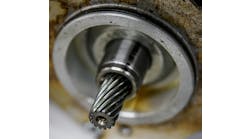Tom Jensen joined Beckhoff USA as assembly industry manager. With an extensive background in automation, Jensen will expand Beckhoff market share in wide-ranging applications. His mechatronics expertise will help assembly customers to streamline production of complex products and drive new design concepts using the eXtended Transport System (XTS) and other New Automation Technology innovations.
Jensen comes to Beckhoff after a successful term as general manager of AMK Automation, a PC-based automation and motion control vendor. He has held senior business development roles at Lenze Americas, B&R Industrial Automation and Laird Connectivity, in addition to being a senior support engineer for FANUC America. He also spent a decade at ELAU, now part of Schneider Electric, as a manager for engineering and business development.
Jensen’s efforts on open automation standards at MHI, the Organization for Machine Automation and Control (OMAC) and PMMI, The Association for Packaging and Processing Technologies, are well known in the automation industry and will benefit Beckhoff. “I am excited to work with the skilled team of engineers at Beckhoff USA to help customers implement new assembly machine designs with Industry 4.0 concepts,” Jensen says. “Technologies like XTS have proven their power around the world, and the breakthrough of flying motion and path planning with XPlanar will further grow market share in assembly.”
Jensen is co-founder of Industrial Automation Jumpstart, an education and outreach program for Chicago high school students, and he sits on the advisory board for Purdue University Northwest’s mechatronics program.
Tom Jensen answered 7 questions about the future of automation technology.
What are three key things that a machine builder, system integrator or manufacturer should know about your company?
Tom Jensen, assembly industry manager, Beckhoff Automation: To start, Beckhoff was the first major technology provider to supply industrial PCs (IPCs) with real-time capabilities. We have been doing this for decades, and we know what we’re doing.
Also, we design and manufacture all of our products in-house giving us complete control of everything from the supply chain to overall functionality. Made in Germany, quality also means that the components offer the utmost reliability and durability.
And finally we embrace standards as a pathway to easy adoption of our solutions. As a universal engineering and runtime environment, TwinCAT 3 automation software enables traditional PLC programming, computer science languages and industry-specific standards, rather than black boxes and proprietary software for each system. To use Beckhoff technologies, you only need to know your industry standards and a little more.
What new technologies are driving your product development and why?
Tom Jensen, assembly industry manager, Beckhoff Automation: Many recent Beckhoff developments have focused on linear motion solutions, so that machine-builder OEMs have more ways to innovate for their end users. Until recently, linear motor technology has been out of reach in terms of cost, size and performance for smaller machine types, particularly in packaging and assembly, for example. The eXtended Transport System (XTS) from Beckhoff is a linear transport system that delivers significant power and precision in a compact package that minimizes cabling.
Beckhoff development has extended advanced motion control concepts with the XPlanar transport solution, giving even more design options to OEMs challenged with making batch-size-one machines for an ever-changing consumer market. The XPlanar is a non-rotary, flat planar motor solution that provides dynamic motion via floating tiles in X, Y and Z, in table or track forms. Path planning and collision avoidance functionality ensure that the workpiece arrives at the next station in the shortest time possible, including for individual products requiring customization or other processes. Since the XPlanar tiles levitate, there is zero wear on moving components.
How does the Industrial Internet of Things figure in your business strategy?
Tom Jensen, assembly industry manager, Beckhoff Automation: IT and automation convergence has been at the center of Beckhoff’s solutions from the beginning of the company, and long before the IIoT term was born. Because the core of Beckhoff technology is PC-based control, involving RAM, ROM, CPU, operating system (OS), real-time OS (RTOS) and communication interfaces, we have been interfacing machines to networks safely for decades. Our new compact IPCs easily play the role of edge computers and are capable of interfacing thousands of devices to networks in microseconds.
How will machine automation and controls alter the way companies staff their operations in the future?
Tom Jensen, assembly industry manager, Beckhoff Automation: Automation, when applied properly, will continue to change the productivity and product offerings of most manufacturers across industries. It will also change what folks do from physical machine interaction to production flow roles, such as scheduling, quality control, maintenance and so on. Because automation will increase plant throughput, staffing levels should remain stable, and employees will simply cross-train to take on other and in some cases brand new roles.
How is the development of software solutions impacting your requirements for hardware?
Tom Jensen, assembly industry manager, Beckhoff Automation: Very little. Beckhoff designs both hardware and TwinCAT software solutions as fully integrated and completely scalable from the start. As such, we are free to move a software solution up or down within our broad IPC portfolio to tailor each machine to a control with the right performance level. Secondly, our automation hardware set, in terms of I/O, motion and connectivity, is complete and covers the gamut of machine control requirements.
As engineering and IT continue their convergence, which one is and/or will be leading the direction of future automation and technology at your organization?
Tom Jensen, assembly industry manager, Beckhoff Automation: Saying one will lead the way alone is not as accurate as saying together they’ll lead companies forward. It’s not either/or; it must be a collaboration. As mentioned before, Beckhoff has driven IT and automation technology (AT) convergence from the very beginning. This guides us in how we design our hardware, software and networking solutions.
The industrial PC born in the 1980s has ruggedized powerful PC hardware for deployment in machine control and plant applications. The TwinCAT PC-based software originating in 1996 is multifunctional and can now handle the engineering and runtime for PLC, motion control, robotics, safety and much more. The EtherCAT industrial Ethernet system that launched in 2003 harnesses the power of Ethernet without the baggage of Internet for fast, inexpensive and reliable industrial networking.
Looking into the future, how will technology change your company over the next five years?
Tom Jensen, assembly industry manager, Beckhoff Automation: A little and a lot. It will affect us to a small extent because Beckhoff was founded to offer dynamic ways to create products quickly for a given market. This includes new software, hardware and materials, so in this respect, we will not change. We are an agile organization, and the company’s founder, Hans Beckhoff, remains the owner and managing director. So we are always ready for new opportunities.
New technology will impact us profoundly because we are working to connect in a smart way to new industries and customers. This means we need to become and remain a good neighbor to those industries. We need to work in the neighborhood, build up industries and integrate their needs into our product offerings. This is a change that most technology companies can’t afford to make because it takes time, resources and understanding to make meaningful progress in the community, not just flood the market with me-too products. XPlanar, advanced controls and many other New Automation Technology solutions prove that Beckhoff is ready and committed to driving real change.
Sponsored Recommendations

Leaders relevant to this article:



